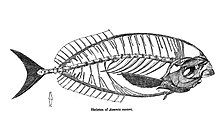Louvar
The louvar or luvar (Luvarus imperialis) is a species of perciform fish, the only extant species in the genus Luvarus and family Luvaridae. It is closely related to the surgeonfish. The juvenile form has a pair of spines near the base of the tail, like the surgeonfish, though they are lost in the adult.
| Louvar | |
|---|---|
 | |
Not evaluated (IUCN 3.1) | |
| Scientific classification | |
| Kingdom: | |
| Phylum: | |
| Class: | |
| Order: | |
| Suborder: | |
| Family: | Luvaridae T. N. Gill, 1885 |
| Genus: | Luvarus Rafinesque, 1810 |
| Species: | L. imperialis |
| Binomial name | |
| Luvarus imperialis Rafinesque, 1810 | |
| Synonyms | |
|
For genus:
For species:
| |
It is a large, ellipsoidal fish, growing to 200 cm (79 in) long, though most do not exceed 152 cm (60 in). The greatest weight recorded for this species is 150 kg (330 lb).[3] It is pink in color and possesses a characteristic bulging forehead.
It is found in surface waters of temperate and tropical oceans throughout the world where it can be found at depths of from near the surface to 200 m (660 ft). It feeds on jellyfish, ctenophores, and other soft-bodied planktonic animals. It is hardly ever found in fish markets in the United States, only as bycatch, but is prized as an eating fish.[4]
Extinct taxa

One extinct species in the genus Luvaris and two extinct genera are only known from fossils dating back to the Paleogene, three extinct genera if one includes Kushlukia of the monotypic Kushlukiidae:
- Luvaris necopinatus (from the Danata formation)
- Avitoluvarus (from the Danata Formation)
- Beerichthys (from the London Clay fauna)
- Kushlukia (sister taxon of Luvaridae)
Timeline

References
- Histoire naturelle des poissons, Volume 22, Georges Cuvier, 1833
- Histoire naturelle des principales productions de l'Europe méridionale et particulièrement de celles des environs de Nice et des Alpes Maritimes. Risso, A. (Antoine), Paris, F.-G. Levrault, 1826, tome III, page 267, doi:10.5962/bhl.title.58984
- Froese, Rainer and Pauly, Daniel, eds. (2013). "Luvarus imperialis" in FishBase. December 2013 version.
- "Louvar: A Fish You May Never Taste". Larry Levine, Table Talk at Larry's. January 3, 2012.
External links
- "Luvarus imperialis". Integrated Taxonomic Information System. Retrieved 18 April 2006.
- Froese, Rainer, and Daniel Pauly, eds. (2006). "Luvaridae" in FishBase. February 2006 version.
- "Louvar". Australian Museum Fish Site. Retrieved 31 March 2006.
- "Phylogenetic Revision of the Fish Families Luvaridae and †Kushlukiidae (Acanthuroidei), with a New Genus and Two New Species of Eocene Luvarids" Contains information about Luvaridae and Kushlukiidae (Acanthuroidei).